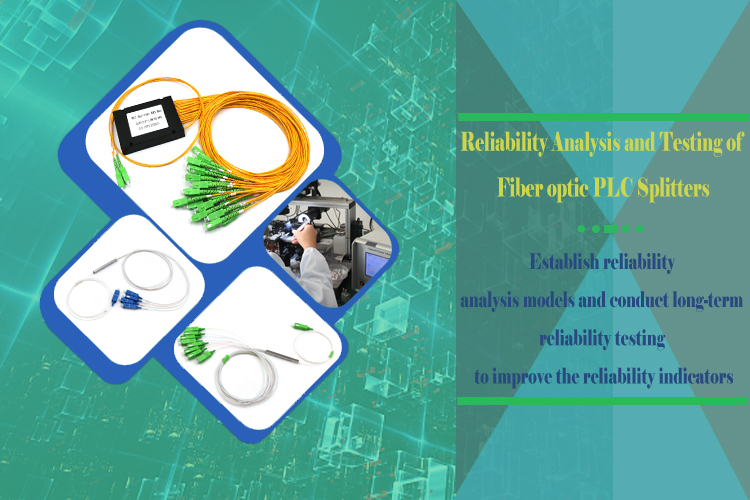Reliability Analysis and Testing of Fiber optic PLC Splitters
Establish reliability analysis models and conduct long-term reliability testing to improve the reliability indicators of Fiber optic PLC Splitters
Fiber optic passive lightwave components, especially fiber optic PLC splitters, play a critical role in optical networks. Their reliable operation directly affects the quality of service and performance of the entire network. Therefore, establishing reliability analysis models and conducting long-term reliability testing of PLC splitters is crucial.

Reliability Modeling
Traditional reliability models such as the Weibull, exponential, and lognormal failure rate models can be used to analyze the failure rate and reliability function of PLC splitters. Appropriate statistical tools then determine the best-fit model based on the failure data collected during field operation and accelerated life testing.
The Weibull distribution is often more suitable for modeling the reliability of PLC splitters due to its flexibility. The Weibull reliability function can be expressed as:
R(t) = exp[-(t/η)β]
Where η is the characteristics life and β is the shape parameter. The value of β indicates the failure mechanism. Values of β <1 indicate decreasing failure rate, β =1 indicates constant failure rate, and β >1 indicates increasing failure rate.
Accelerated Life Testing
Besides field failure data, accelerated life testing under conditions of high temperature, humidity and electrical stress can provide valuable information on the degradation and failure mechanisms of PLC splitters. An Arrhenius model or Eyring model can relate the failure rate under accelerated conditions to the actual operating conditions using a temperature acceleration factor.
Test results provide opinions into which components and materials are more susceptible to failure, allowing engineers to implement targeted design changes and material selection for improved reliability.
Monitoring and Preventive Maintenance
Continuous monitoring of key parameters such as insertion loss, return loss and polarization dependent loss through an optical time domain reflectometer (OTDR) helps detect abnormalities and potential failures at an early stage. This enables preventive maintenance actions to be taken before a catastrophic failure occurs.
Establishing a regular maintenance schedule that involves cleaning dust/contamination from exposed surfaces and performing parameter checks can significantly improve the mean time between failures (MTBF) of PLC splitters.
FAQs
Q: What are the major failure modes of PLC splitters?
A: The major failure modes of PLC splitters include increase in insertion loss, worst return loss specification, complete power loss, increased polarization dependent loss and failure of mechanical and optical connectors and fiber joints.
Q: Why is accelerated life testing conducted?
A: Accelerated life testing is conducted to gather failure data faster than is possible during actual operation. It subjects components to higher stress levels in order to speed up failure mechanisms. This helps find weaknesses in design and reliability issues at an early product development stage.
Q: What factors affect the reliability of PLC splitters?
A: The factors that affect the reliability of PLC splitters include: material properties, manufacturing quality, operating temperature, environmental stress, load stress, input optical power, aging, contamination and vibrations during transportation.
Q: How can insertion loss fluctuations in PLC splitters be mitigated?
A: Insertion loss fluctuations in PLC splitters can be mitigated by: protecting exposed fiber ends and connectors from contamination, ensuring proper clamping of fibers to reduce microbending loss, cooling the device to reduce thermally induced loss, and hermetically sealing the assembly to avoid penetration of moisture and particulate matter.
Q: What is the purpose of preventive maintenance for PLC splitters?
A: The purpose of preventive maintenance for PLC splitters is to: detect degradation before failure occurs, reduce failure rates, extend the useful life, improve performance consistency, minimize downtime, and reduce long-term costs by avoiding costly component replacement.
Key Words: fiber optic PLC splitters, reliability analysis models, reliability indicators, failure rate model, Weibull distribution, accelerated life testing, preventive maintenance, insertion loss

 The Future of Fiber Optic Communication Network Architecture: Evolution and the Role of SDON Technology
The Future of Fiber Optic Communication Network Architecture: Evolution and the Role of SDON Technology
 What opportunities and challenges does free-space optical communication technology face?
What opportunities and challenges does free-space optical communication technology face?
 Opelink MPO Products for High-Speed Data Center Applications
Opelink MPO Products for High-Speed Data Center Applications
 CWDM vs. DWDM: Which Optical Transmission Technology Should You Choose?
CWDM vs. DWDM: Which Optical Transmission Technology Should You Choose?